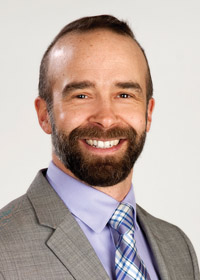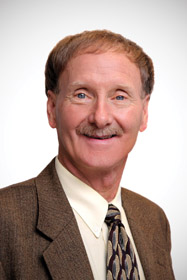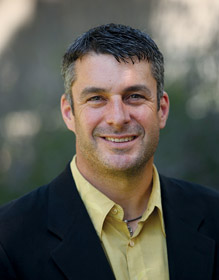
Sometimes it takes more than a paycheck to provide job satisfaction, and today’s young workers are incorporat- ing both workplace and community responsibilities to find that satisfying balance. The 2017 Deloitte Millennial Survey reports that 77 percent of young employees get involved in charitable work in some way, and when their employers support their activities, they believe their efforts have a greater impact. The result is an engaged workforce with employees who have a sense of purpose and feel loyal to the companies that employ them, and paying attention to their ethic pays off for everyone.
Company culture
Service to the community is an integral part of the culture at Redwood Credit Union. “It’s inherent in our business model. We’re just passionate about it here, each and every day,” says Matt Martin, vice president of community and government relations. RCU has a large group of employees who are under 30. “We recognize that our young employees are our professional future,” he says. RCU’s internal surveys consistently reflect that more than 99 percent of employees say they’re proud of RCU’s community involvement, and they’ve found many new applicants say it’s one of the top reasons they’re drawn to work at RCU. For prospective employees with that kind of motivation, it’s a good fit.  One of RCU’s pillars as a financial cooperative is community involvement, and shared values are an importantconsideration in the hiring process. “It’s one of the primary filters,” says Martin, and it’s a successful strategy that is reflected in the outcome. “We never have a shortage of volunteers,” he says.
One of RCU’s pillars as a financial cooperative is community involvement, and shared values are an importantconsideration in the hiring process. “It’s one of the primary filters,” says Martin, and it’s a successful strategy that is reflected in the outcome. “We never have a shortage of volunteers,” he says.
Sponsorships, bike races and underwriting for community events and parades are among RCU’s many avenues for outreach. “There’s something for everyone,” says Martin. According to Martin, that includes meaningful opportunities, not just writing checks—an approach that’s especially appealing to young people who like to do hands-on work in the community. “We empower our employees to be everyday active Redwood Credit Union ambassadors at events,” he explains, and the common thread is having fun. As an example, earlier this year, RCU held a shred-a-thon in Santa Rosa to help members of the public safely dispose of old documents, and raised $3,500 in donations for the Redwood Empire Food Bank. Martin calls it a triple win. At such events, employees are engaged, provide a service for people and help the community’s most vulnerable all at the same time. “Our employees left there grinning from ear-to- ear,” he says.
Reddy, Set, Grow is an employee wellness program that engages younger employees in particular, because it offers fitness challenges for participants, who can reach their step or activity goals while volunteering for charity walks and food packing. “We see our younger employees come out to those more physically active events,” Martin reports. They also assisted at Chop’s Teen Club’s free job prep summit, #GetThatJob, helping young people to learn soft skills, such as resumé writing, appropriate dress and how to conduct themselves in an interview. And RCU’s Bite of Reality—financial fairs with interactive learning events that teach high school and college students how to navigate real-world financial challenges—is also a popular volunteer event. He points out that young employees may not be that much older than teens they’re helping at these events. “Kids think that’s cool and see them as relatable,” he says. In addition, the experience helps employees grow personally and develop leadership, communications and collaboration skills, as well as giving them an opportunity to belong to a community or purpose larger than themselves. Martin sees young staff members developing as individuals and leaders and finds it thrilling to watch them get energized by giving back.
Arrow Benefits Group, a mid-size employee benefits and human resources consulting firm in Petaluma, incorporates similar values into its business model with Culture Insights, a program specifically designed to help an employer create a company culture that will help them attract and retain the employees they need to be successful as an organization. Andrew McNeil, 31, the firm’s principal, explains that the attitude of Millennials is completely different to that of previous generations, and making an impact is often more important to them than just making money. “Many people in our organization want to volunteer (not just Millennials),” he says, and Arrow gives them paid time off to do it. “If they value it, so do we,” he says. Arrow also offers a charitable-gift matching program and sponsors local events, such as Big Brothers and Big Sisters’ Bowl for Kids’ Sake and the American Heart Association’s Go Red for Women. McNeil considers heart-related activities important personally, because heart disease has had an impact on his own family, and Arrow hasinstalled Automated External Defibrillators in several businesses in Sonoma County. “We’re big on getting AEDs out into the business community,” he says. Employees also do stints at Ceres Community Kitchen in Sebastopol and work at an organic farm that grows food for low-income families. McNeil finds that when a company cares about the causes its employees believe in, it’s empowering. “It gives people a voice,” he says. “You are supporting the people who are supporting you, and you are supporting the community that supports you. It’s all intertwined. It’s always a good thing to give back to the community where you live and make it stronger.”
Leadership
At Keysight Technologies in Santa Rosa, NextGen is a long-running program offering young employees opportunities to engage in networking and programs that encourage them to grow personally as well as in their careers and to develop a sense of community. “Supporting employee volunteerism in the community benefits Keysight, because it contributes to the company’s corporate social responsibility goal to be a major contributor in communities where we operate,” says public affairs manager Jeff Weber. He reports that Keysight’s policy allows employees to take off four hours of paid time each month to engage in volunteer activities. In September, the company worked with United Way of the Wine Country to coordinate 22 volunteer projects for Keysight’s Day of Caring, in which 400 employees spent the day working at local nonprofit organizations.
Matt Chan, 32, is an R&D integrated circuit engineer who is an enthusiastic participant in NextGen’s outreach programs. For two years, he has gone to Sam Jones Hall, a homeless shelter for adults in Santa Rosa, to paint, clean the kitchen and bathrooms, and complete small projects including building basketball hoops for the residents. “Going there has a huge impact, because you can see the benefit you can bring to people’s lives,” he says.
In addition, he coordinated an event for Keysight’s annual giving program, which raised more than $760,000 in employee donations and matching funds from the Santa Rosa headquarter office alone, for various local nonprofit organizations and charities. Keysight has employees who enjoy playing ping-pong at lunch, so he planned a tournament in 2016, and bake sales and soccer tournaments contributed revenue, too. The activities vary annually. “One year, we had a cool classic car show,” he adds, with hot rods, muscle cars and a Model T Ford.
Chan’s favorite event is Keysight’s Introduce a Girl to Engineering Day, which the company has hosted for 14 years. This year, he was the event chair, and 120 students (grades 6 through 12) visited for a day of hands-on engineering activities. “It’s a big day. It has company involvement throughout,” Chan says. The core team designs a hands-on engineering activity, and 60 volunteers from all areas help, he explains. They put the students into teams of four or five. “It’s a safe place for them to try something and see if they can accomplish the task,” he says. They might have to build a self- propelled car and see which can go the fastest across the finish line or do a zip line project that has them move as many ping-pong balls as they can from one end to the other. He’s excited about giving girls the opportunity and says, “Anybody can be an engineer. You can engineer out of anything—string, paper, rubber bands.” He adds that a keynote speaker is a highlight of the day, and this year, Dr. Grace Colón, president and chief executive officer of InCarda Therapeutics, did the honors. “Introduce a Girl to Engineering is the project I get the most satisfaction out of,” Chan says. “Empowering younger generations makes the future much brighter.”
 Chan, who grew up in Novato and earned a bachelor’s, master’s and Ph.D. from the University of California, Berkeley, has been at Keysight Technologies for four years. He recalls that when he interviewed at the company (before it was spun off from Agilent) he learned about NextGen, which was then called Next Wave, on a tour. “When I did the tour, they showed me the company garden,” he says, explaining that it works on a lottery system, and winners get a plot. What impressed him most, though,was discovering that the cafeteria uses part of the garden to grow its own produce and hires adults with special needs to tend it, allowing them to become independent and do something meaningful. “The company doesn’t have to do that, but they go above and beyond,” he says. He observes that outreach programs have support all the way to the top, and members of management work side by side with employees on projects to help the local community. “I feel that having a company that gives back to the community really strengthens its bond. The better you can make the community, the better it is for everyone,” he says. “It makes me feel good that the company cares.”
Chan, who grew up in Novato and earned a bachelor’s, master’s and Ph.D. from the University of California, Berkeley, has been at Keysight Technologies for four years. He recalls that when he interviewed at the company (before it was spun off from Agilent) he learned about NextGen, which was then called Next Wave, on a tour. “When I did the tour, they showed me the company garden,” he says, explaining that it works on a lottery system, and winners get a plot. What impressed him most, though,was discovering that the cafeteria uses part of the garden to grow its own produce and hires adults with special needs to tend it, allowing them to become independent and do something meaningful. “The company doesn’t have to do that, but they go above and beyond,” he says. He observes that outreach programs have support all the way to the top, and members of management work side by side with employees on projects to help the local community. “I feel that having a company that gives back to the community really strengthens its bond. The better you can make the community, the better it is for everyone,” he says. “It makes me feel good that the company cares.”
The appreciation is mutual. “Besides being a solid contributor in his job, Matt clearly is involved in helping Keysight meet its corporate social responsibility goal to be a positive influence in the community,” says Weber.
Learning curve
For some young people, the desire to help others comes naturally, instilled in them by Baby Boomer parents who recognize the value of service and understand its strength. Others developed the same ethic during service-learning projects at school and fulfilling requirements for community service. With that experience, putting a passion for nonprofit work into action is often easy for them. For students from underrepresented communities, especially those who are the first in their families to attend college, passion for giving back is a central part of who they are.  “They are very aware that other people helped them, are grateful for the support they received and they want to give back to help others,” says Dr. William Silver, dean of the school of business and economics at Sonoma State University. He reports that thanks to a generous donation from Rodney Strong Vineyards in Healdsburg, SSU offers the Rodney Strong Pathways Program to teach students how they can make a difference in the organizations for which theywork, and for the communities in which they live. The Kalmanovitz Charitable Foundation of Mill Valley provided $1.7 million to establish the Kalmanovtiz Academy, a program to support the students’ academic and career success, so they are ready to take on this challenge. Dr. Adele Santana’s classes
“They are very aware that other people helped them, are grateful for the support they received and they want to give back to help others,” says Dr. William Silver, dean of the school of business and economics at Sonoma State University. He reports that thanks to a generous donation from Rodney Strong Vineyards in Healdsburg, SSU offers the Rodney Strong Pathways Program to teach students how they can make a difference in the organizations for which theywork, and for the communities in which they live. The Kalmanovitz Charitable Foundation of Mill Valley provided $1.7 million to establish the Kalmanovtiz Academy, a program to support the students’ academic and career success, so they are ready to take on this challenge. Dr. Adele Santana’s classes
in leadership and innovation make firsthand experience working in the community part of the curriculum, and students go off campus to lend a hand at locations such at Kaiser Permanente and the Sonoma County Library. “In our leadership classes, we’re working with students on these service-learning projects teaching them that their passion can be their purpose,” says Silver.
In addition, he encourages business students to interact with leaders, to network and to find out what opportunities exist and how to engage in them. For example, he suggests that students attend the monthly lunch meetings of Los Cien, a Sonoma County leadership organization. Through their experience in the community, some learn about social entrepreneurship and discover they can have a dramatic impact if they build businesses that solve problems in the community, create jobs and become philanthropists. “Students don’t always know that’s an option for them,” say Silver. The programs at SSU make them aware of ways they can contribute to the community when they enter the business world and embark on careers.
Making a difference
As Millennials become dominant in the workforce, their principles are increasingly important. “This is a generation that has a strong value for following their passions and working for companies that are making a difference in the places they live,” says Silver. He points out that young people expect to be contributing members of the community and want to work for companies that match their values, so businesses need to respond. “They need an employment brand that shows how they are making a difference in the community,” he says. “It will be difficult to attract Millennials otherwise.” This generation is out to change the world,
and they see business as a powerful way to do it.
Sidebar 1: Making a Mark
Fortune magazine named Autodesk, Inc. as one of the best 100 companies to work for in 2017, with 93 percent of its employees saying they feel good about the way they and their employer contribute to the community. Autodesk is a multinational company that got its start in Mill Valley and has headquarters in San Rafael.  Ben Thompson, head of employee impact, highlights the following corporate altruism initiatives:
Ben Thompson, head of employee impact, highlights the following corporate altruism initiatives:
• A Match & Volunteer site that allows employees to log volunteer hours and manage donations.
• Matching policy for donations. • Fundraising idea toolkits for projects and ideas. • Cause cards for every 10 hours of volunteer work an
employee logs. “These cause cards are like gift certificates for donations—used like cash to donate to the charity of choice,” says Thompson.
• Impact champions who lead engagement projects of their choice, with assistance from the company, which provides tools such as project-design outlines and communications templates to help.
• The Autodesk pro bono program, which allows employees to share their professional skills to impact designers, nonprofits and start-ups.
• Encouragement for employees to serve on the boards of charitable organizations and doubling the financial contributions they make
Sidebar 2: Leading the Way
It might seem like a new concept, but the practice of corporate entities reaching out to the
communities where they are located and supporting the causes their employees believe in goes back 60 years. Hewlett Packard is known as a leader in developing a corporate culture that makes commitment to the community an objective, and it has been doing so since 1957. The Palo Alto-based company encourages its employees, who number 300,000 worldwide, to become involved in their communities in many ways.
It contributes millions of dollars in donations through a matching- fund program, donates products through gift-in-kind programs, and its employees and retirees give thousands of volunteer hours to HP programs and community initiatives.
—Source: HP in the Community, hp.com




